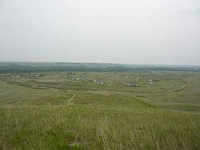|

Blackfoot Crossing Historical Park is a complex of historic sites on the Siksika 146 Indian reserve in Alberta, Canada. This crossing of the Bow River was traditionally a bison-hunting and gathering place for the Siksika people and their allies in the Blackfoot Confederacy. Nearby are the remains of an ancient earthlodge village, believed to have been built by people from the Upper Mississippi valley in what is now the United States. It is unique in being an example of a permanent village on the plains: an area associated with nomadic hunting. The crossing became an important place in Canadian history when Treaty 7 was signed here between the native nations of what is now southern Alberta and the Canadian government on behalf of the Crown in 1877. It was also here that Crowfoot, chief of the Siksika, is believed to have died and been buried. As well, Poundmaker, a chief of the Cree who had been ceremonially adopted by Crowfoot in order to create peace between the Blackfoot and the Cree, was also buried here until being moved in 1967. In 1925 the traditional gathering site and the treaty signing site were declared National Historic Sites of Canada by the federal government's Historic Sites and Monuments Board of Canada. In 1972, the earthlodge village was also declared a national historic site.[2]






 Please share your ideas with us.
Please share your ideas with us.